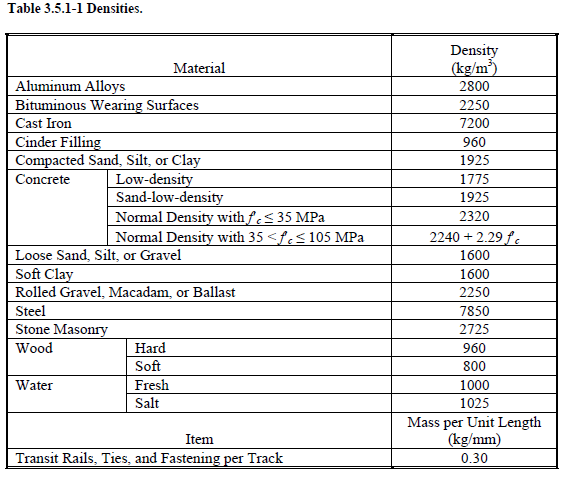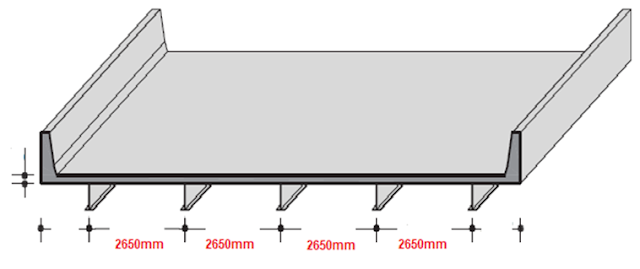The design of the superstructure includes the deck system. Gongkang Fu shows a flowchart on the procedure of designing the deck system as follows:
 |
| Bridge Design and Evaluation LRFD and LRFR |
Specifications included in the flowchart are articles from AASHTO Bridge.
Similar to how the design of any structure starts, the design loads should be identified to determine the dimensions required.
PRIMARY REINFORCEMENT REQUIREMENTS
The traditional design method involves the different steps in the design of the primary deck reinforcement:
- Obtain design criteria.
- Determine the minimum slab and overhang thicknesses.
- Select slab and overhang thickness.
- Compute dead load and live load effects.
- Compute factored positive and negative design moments.
- Design for positive flexure in deck.
- Check for positive flexure cracking under service limit state.
- Design for negative flexure in deck.
- Check for negative flexure cracking under service limit state.
- Design for flexure in deck overhang.
- Check for cracking in overhang under service limit state.
- Compute overhang cut-off length requirement.
- Compute overhang development length.
- Design bottom longitudinal distribution reinforcement.
- Design top longitudinal distribution reinforcement.
- Design longitudinal reinforcement over piers.
- Draw schematic of final concrete deck design.
The basic design criteria include:
- Girder spacing
- Number of girders
- Deck top cover
- Deck bottom cover
- Deck unit weight
- Deck concrete strength, f'c
- Reinforcement strength, fy
- Future wearing surface thickness
- Future wearing surface unit weight
LOAD ANALYSIS FOR DESIGN
The main goal for the load analysis is to come up with the moments needed to design the reinforcement. The formula for the moment is as follows:
+\gamma&space;_{_{p,DC}}\left&space;(&space;M_{DLparapet}&space;\right&space;)+\gamma&space;_{_{p,DW}}\left&space;(&space;M_{DLws}&space;\right&space;)+\gamma&space;_{_{LL}}\left&space;(&space;M_{LL}&space;\right&space;)) The
The  are taken as load factors which can be determined from the AASHTO tables for load factors of permanent loads and all other loads.
are taken as load factors which can be determined from the AASHTO tables for load factors of permanent loads and all other loads.
 |
| AASHTO 2007 Edition SI units |
 |
| AASHTO 2007 Edition SI units |
The moments result from using any method to determine moments for indeterminate structures such as:
- Moment distribution
- Three-moment equation
- Slope deflection method, etc.
SOLVING FOR THE DEAD LOAD
The DL can be solved simply by using the equation:
Dead load = unit weight (cross-sectional area)
For unit weight of materials, AASHTO provides the following table:
 |
| AASHTO 2007 Edition SI units |
DIMENSIONING THE BRIDGE
A bridges length and width will be determined through site inspection. The length of which can be measured from end to end of the valley or water form which requires a passage. The bridge's width adopts the road width.
The number of girders will be upon the bridge designer's discretion; guided by the conditions that:
- The minimum number of girders for a bridge is 4
- 5 girders are efficient to carry loads all throughout the bridge
THE OVERHANG WIDTH
As a rule of thumb, a bridge's overhang is taken within 30% to 50% of the girder spacing.
SLAB AND OVERHANG THICKNESS
The minimum depth and cover as stated in the AASHTO is 175mm (which excludes a sacrificial wearing surface). The thickness will have to account for the:
- wearing surface thickness,
- the cover, and
- the main bar diameter.
Table 5.12.3-1 lists the cover for unprotected main reinforcing steel.
 |
| AASHTO 2007 Edition SI |
The slab thickness can be determined from the table:
 |
| AASHTO 2007 Edition SI |
HEIGHT OF TRAFFIC PARAPET OR RAILING (13.7.3.2.)
The minimum height for a concrete parapet with a vertical face shall be 685mm. The typical height considered in most designs is 1000mm.
SOLVING FOR THE LIVE LOAD
Most bridge designers compute for the live load effects using the tenth rule whereby the moving loads (and influence lines) would have to be analyzed in 10 divisions.
Table A4-1 from AASHTO 2007 lists maximum live load moments.
 |
| AASHTO 2007 Edition SI |
Click here for pdf file on LOAD ANALYSIS
Click here for pdf file on DESIGN OF DECK
















